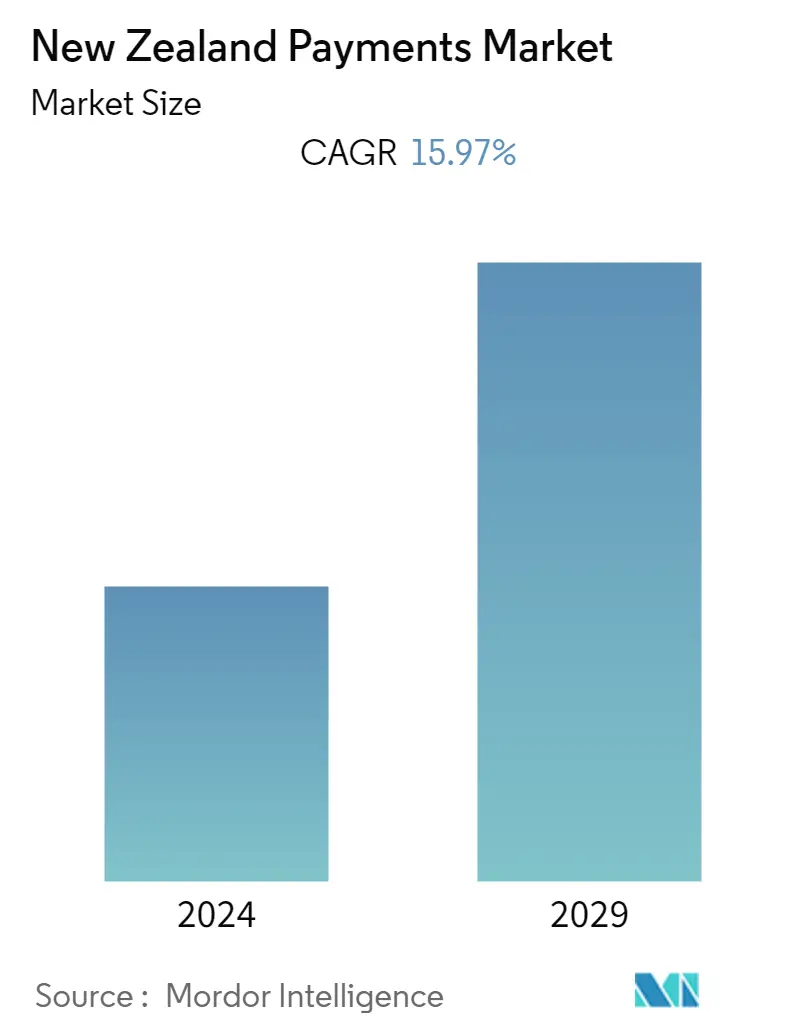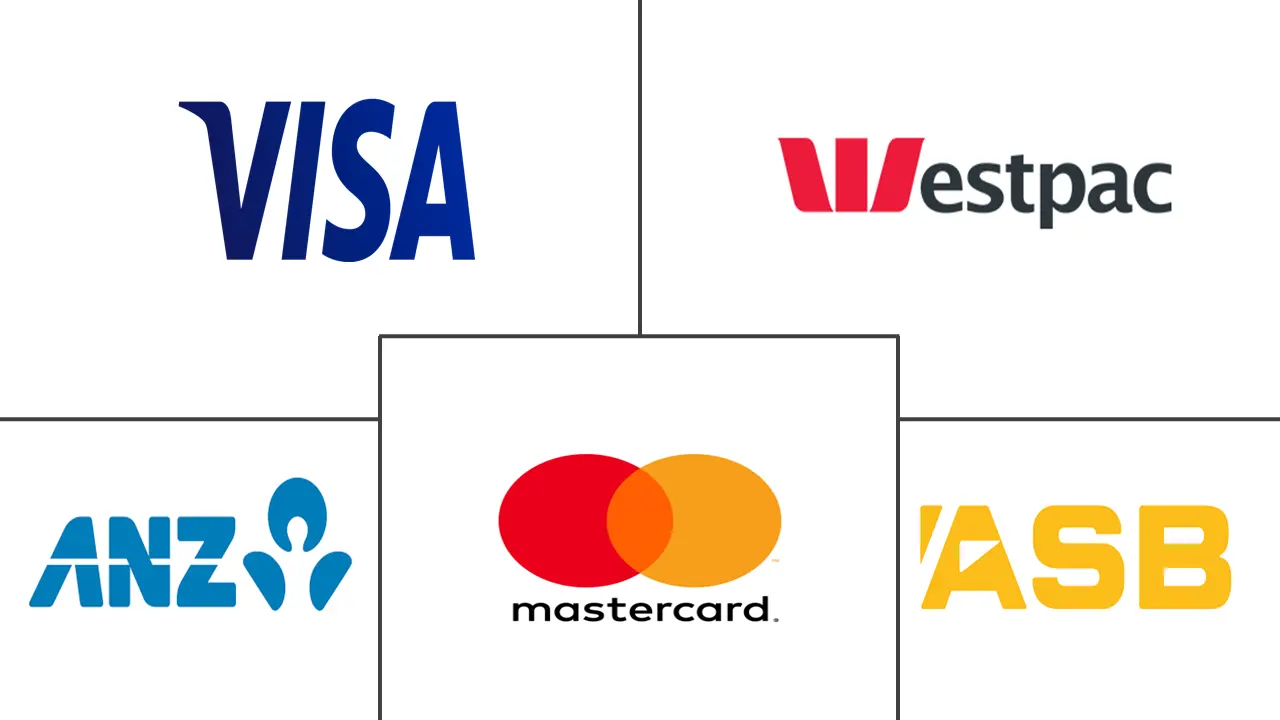Market Size of New Zealand Payments Industry

| Study Period | 2019 - 2029 |
| Base Year For Estimation | 2023 |
| Forecast Data Period | 2024 - 2029 |
| Historical Data Period | 2019 - 2022 |
| CAGR | 15.97 % |
| Market Concentration | Medium |
Major Players
*Disclaimer: Major Players sorted in no particular order |
New Zealand Payments Market Analysis
- The New Zealand payments market is expected to grow at a CAGR of 15.97% over the forecast period (2022 - 2027). New Zealand has long been one of the highly developed electronic payments markets. Cash is rarely used, and consumers are quick to adopt new technology. The payment cards market is well established, with high consumer penetration and merchant acceptance.
- Visa and Mastercard are betting big on contactless payments. Both companies' debit cards are contactless. In response to the coronavirus outbreak, Visa and Mastercard increased the contactless payment limit from NZ$80 ($53.96) to NZ$200 ($134.89), effective April 9, 2020. This should help boost contactless payments in the future.
- Online payment habits in New Zealand are parallel to those in Australia, with credit and debit cards being the most popular payment methods. Like Australia, e-Wallets are gaining market share - PayPal and POLi, which is a must payment option to offer.
- To capitalize on the growing preference for online shopping, Westpac partnered with Paymark in January 2018 to introduce Online EFTPOS. Customers can use the service to pay for online purchases using the banking app, eliminating the need to provide bank account or payment card information. The customer approves the payment via their bank's mobile app. Apart from Westpac, Online EFTPOS is supported by ASB, The Co-operative, and Heartland Bank.
- The impact of the coronavirus outbreak on the New Zealand economy and the cards and payments industry. While transactional cash use has been declining in general, the COVID-19 pandemic has resulted in a sharp increase in demand for cash in New Zealand. The Reserve Bank issued approximately $800 million in the weeks leading up to the nationwide lockdown in March 2020, compared to $150 million in March 2019.
- According to an EFTPOS NZ9 analysis, contactless payments peaked at 37 % of all payments (by number) through their terminals during the nationwide lockdown, compared to about 17% in a 'normal' month before the pandemic. When compared to before COVID-19, the value of contactless payments increased by about 10%.
New Zealand Payments Industry Segmentation
Payments are increasingly becoming cashless, and the industry's role in fostering inclusion has become a top priority. Payments contribute to developing digital economies and drive innovation, all while serving as a stable backbone around the world.
The payments market is divided into two segments: POS and e-commerce. E-commerce payments include online purchases of both goods and services, such as purchases made on e-commerce websites and online travel and hospitality bookings. In terms of POS, all transactions that take place at a physical point of sale are included in the market's scope.
| By Mode of Payment | ||||||
| ||||||
|
| By End-user Industry | |
| Retail | |
| Entertainment | |
| Healthcare | |
| Hospitality | |
| Other End-user Industries |
New Zealand Payments Market Size Summary
The New Zealand payments market is characterized by its advanced electronic payment systems, with a significant shift away from cash usage. The market is witnessing rapid adoption of contactless payment technologies, driven by major players like Visa and Mastercard, who have expanded contactless payment limits to encourage usage. The popularity of online payments is on the rise, with credit and debit cards leading the way, alongside the growing acceptance of e-Wallets such as PayPal and POLi. The introduction of Online EFTPOS by Westpac, in collaboration with Paymark, highlights the trend towards seamless online shopping experiences, allowing customers to make purchases without sharing sensitive bank details. The COVID-19 pandemic has further accelerated the shift towards contactless payments, as evidenced by a significant increase in their usage during lockdowns.
The market is also seeing a surge in alternative payment methods, with 'Buy Now, Pay Later' (BNPL) options gaining traction. Companies like Klarna and Afterpay are capitalizing on this trend, offering flexible payment solutions that allow consumers to pay in installments. The digital wallet and mobile payment app dosh, launched in New Zealand, facilitates peer-to-peer transactions, while Apple Pay has been integrated with ANZ Bank, enhancing mobile payment options. Card payments remain dominant, with Visa, Mastercard, and American Express being the most widely used for online transactions. The market's infrastructure is complex, with significant costs associated with card payment acceptance, yet it continues to evolve with partnerships and innovations aimed at improving user experiences and expanding payment options.
New Zealand Payments Market Size - Table of Contents
-
1. MARKET INSIGHTS
-
1.1 Market Overview
-
1.2 Industry Stakeholder Analysis
-
1.3 Industry Attractiveness-Porter's Five Force Analysis
-
1.3.1 Bargaining Power of Suppliers
-
1.3.2 Bargaining Power of Buyers/Consumers
-
1.3.3 Threat of New Entrants
-
1.3.4 Threat of Substitute Products
-
1.3.5 Intensity of Competitive Rivalry
-
-
1.4 Evolution of the payments landscape in the country
-
1.5 Key market trends pertaining to the growth of cashless transaction in the country
-
1.6 Impact of COVID-19 on the payments market in the country
-
-
2. Market Segmentation
-
2.1 By Mode of Payment
-
2.1.1 Point of Sale
-
2.1.1.1 Card Payments (includes Debit Cards, Credit Cards, Bank Financing Prepaid Cards)
-
2.1.1.2 Digital Wallet (includes Mobile Wallets)
-
2.1.1.3 Cash
-
2.1.1.4 Others
-
-
2.1.2 Online Sale
-
2.1.2.1 Card Payments (includes Debit Cards, Credit Cards, Bank Financing Prepaid Cards)
-
2.1.2.2 Digital Wallet (includes Mobile Wallets)
-
2.1.2.3 Others (includes Cash on Delivery, Bank Transfer, and Buy Now, Pay Later)
-
-
-
2.2 By End-user Industry
-
2.2.1 Retail
-
2.2.2 Entertainment
-
2.2.3 Healthcare
-
2.2.4 Hospitality
-
2.2.5 Other End-user Industries
-
-
New Zealand Payments Market Size FAQs
What is the current New Zealand Payments Market size?
The New Zealand Payments Market is projected to register a CAGR of 15.97% during the forecast period (2024-2029)
Who are the key players in New Zealand Payments Market?
ANZ Bank New Zealand Limited, ASB Bank Limited, Westpac NZ, Visa Inc and Mastercard Inc are the major companies operating in the New Zealand Payments Market.

